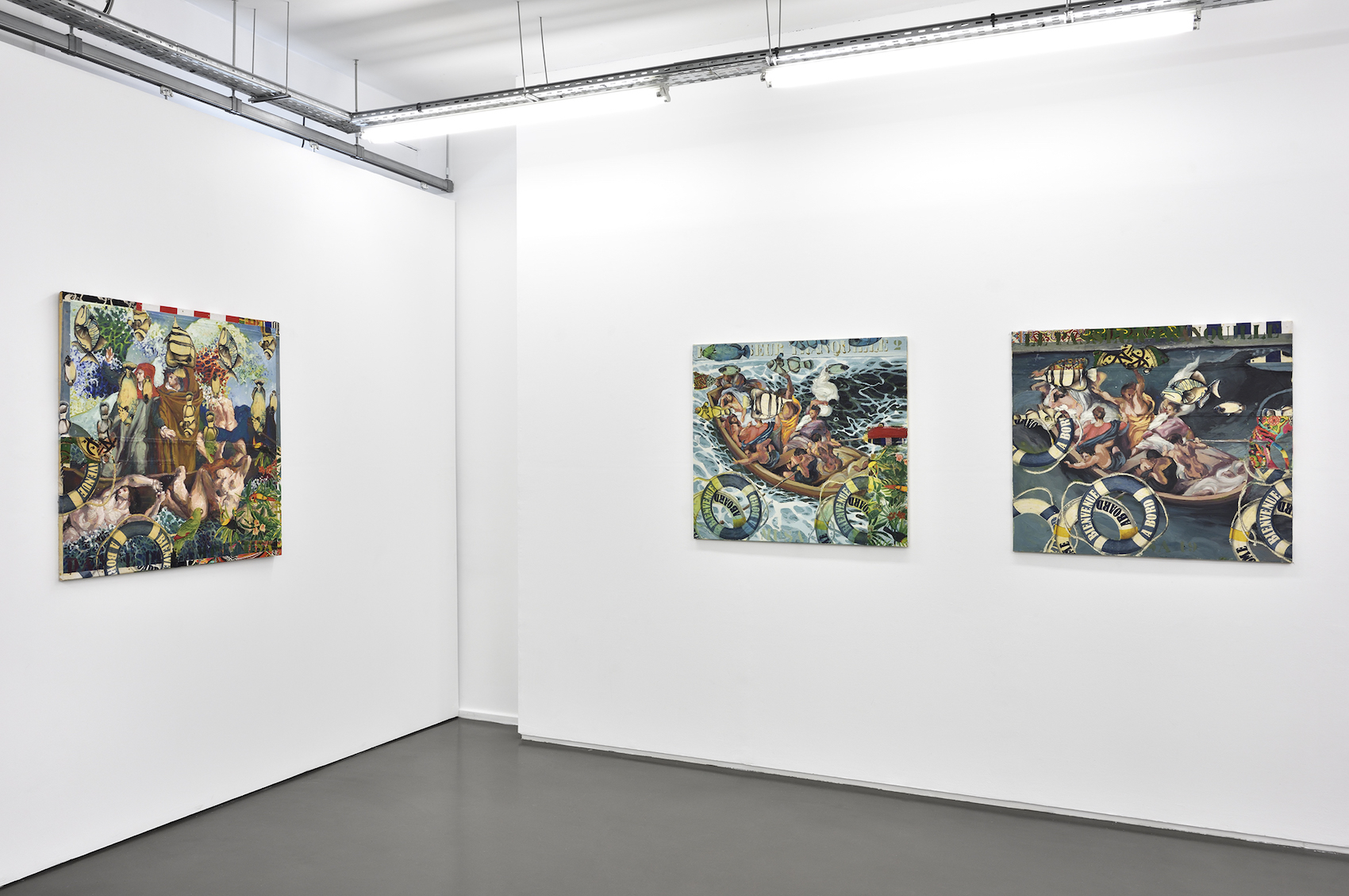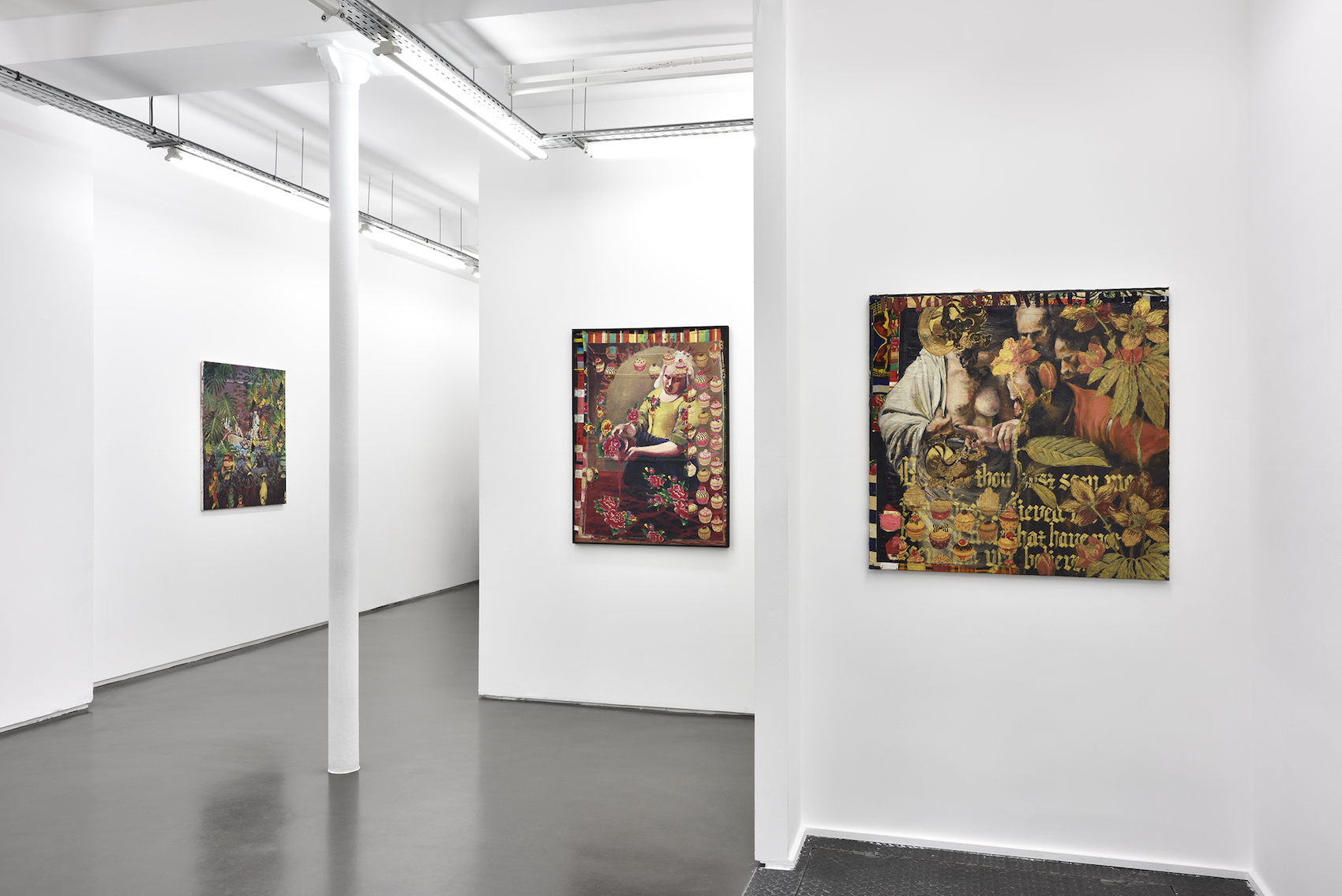Hassan Musa
Les éclaireurs
Hassan Musa ne déteste pas l’ironie et sa connaissance encyclopédique en matière d’art occidental lui a permis de créer un terrain de jeu aux variations infinies.
Son regard sur les œuvres qu’il revisite est nourri par une distanciation du temps et de l’espace. Une distorsion symbolique qui permet de retourner la charge de la preuve, comme on le dirait en droit. Sont convoqués à la barre des témoins, Delacroix, Titien, Caravage, Vermeer, qui se trouvent soudain transportés dans une actualité et une contemporanéité dont ils n’avaient peut-être pas idée, quand bien même ils furent, chacun à leur manière des révolutionnaires. Et c’est peut-être cette idée de révolution, au sens rotation, que l’artiste introduit discrètement, la notion d’éternel retour chère à Nietzsche. Le titre même de cette série, Le passeur tranquille, contient une polysémie qui explore des pistes à la fois intérieures et extérieures. Pour ce qui est de notre temps, Musa insiste sur les flux humains que d’aucuns ont décidé problématiques. Il se débrouille, tout en inscrivant les problématiques très contemporaines dans son œuvre, à faire ces clins d’œil que donne le recul historique.
Les mythes d’alors sont-ils si différents des mythes d’aujourd’hui et, par-dessus tout, qui pourrait bien être ce mystérieux passeur et d’où tire-t-il sa tranquillité ? L’immigration, disons le mot, a besoin de passeurs. Ces ombres qui opèrent dans l’ombre et affrètent des tombeaux flottants. Il y a les passeurs officiels, les organismes internationaux, les États. Le passeur le plus célèbre qui me vienne à l’esprit n’avait pas une tâche facile. Mais n’est-ce pas, au fond, le sort de tout passeur ? Charon devait se boucher les oreilles pour ne pas être ému par les lamentations de ce qu’il allait, une fois le Styx traversé, déposer aux portes de l’enfer. Mais revenons à l’artiste qui, omniprésent dans son projet, nous parle d’autres formes de passages. Hassan Musa ne transporte pas d’humains mais des espaces et des temporalités. Magicien alchimiste, il nous nous fait voyager à travers des décors volontairement anachroniques et visionnaires dans lesquels se mélangent vestes jaunes et éclairs, Lampedusa et Batman, jeux de mots et jeux visuels qui transforment le monde contemporain en un trompe-l’œil révélateur de toutes nos hantises, de nos vices cachés et de nos peurs inavouées. Le passeur, en cette occurrence, pourrait aussi bien être perçu comme un éclaireur, au sens premier du terme : celui qui montre la voie.
Le passeur est également celui qui assure une certaine continuité et se préoccupe des générations à venir, de la mémoire des femmes et des hommes qui ont vécu ; le passeur est un lien. Et cela ne nous surprendra pas que Musa se soit passionné pour l’une des grandes passeuses du vingtième siècle, Joséphine Baker. Malgré les célébrations intempestives et un peu tardives qui, parmi les jeunes filles et les jeunes garçons du vingt-et-unième sait vraiment qui fut Joséphine ? Les mémoires contemporaines sont encombrées d’images d’Epinal : la danseuse à la ceinture de bananes, l’égérie du bal nègre, la reine du Music-Hall. Mais qui sait à quel point Joséphine fut une résistante ? Je ne veux pas mentionner ici son rôle pendant la deuxième guerre mondiale ou d’autres faits comme sa participation au combat de la déségrégation dans les terribles années 50 et 60 aux Etats-Unis. Je veux parler d’une résistance ontologique radicale qui lui a permis de déjouer toutes les idées reçues, tous les clichés et permit, quelles que pussent être les circonstances, d’être toujours elle-même, évoluant d’un monde à l’autre sans se préoccuper des frontières physiques et morales. Et à une époque où certains mauvais apôtres voudraient contraindre des citoyens à renoncer à une part d’eux-mêmes pour prouver leur adhésion à la culture qui les accueille, elle nous rappelle les deux amours qu’elle a clamés haut et fort : « mon pays et Paris ». Elle serait probablement poursuivie aujourd’hui pour apologie du communautarisme.
Il serait stupide (mais nous ne sommes jamais à l’abri de cette maladie hautement contagieuse) d’imaginer que Musa s’est servi d’une actualité passagère pour s’intéresser à la jeune fille de Saint-Louis. Voilà des années, et cela correspond parfaitement à sa quête artistique, que cet alchimiste s’intéresse à la vie de la dame. A la manière dont elle fut perçue, aux malentendus que sa vie a soulevés et à la manière dont elle se présentait au monde. Il est des passeurs, nous l’avons vu, qui exploitent tous les malheurs du monde pour mener à bien leur coupable industrie et d’autres, au contraire, qui ne savent rien faire d’autre que tendre la main à celui qui viendra. James Baldwin, autre grand passeur de notre temps, avait écrit, lorsque les autorités d’une Amérique raciste avait arrêté Angela Davis, cette histoire nous concerne tous : « parce que s’ils viennent pour toi ce soir, ils viendront pour moi demain ».
Musa nous dit que toutes les histoires du monde sont solidaires parce qu’elles sont le fait d’humains. Et rien d’humain ne devrait nous être étranger. C’est ce que nous rappellent les Passeurs Tranquilles du monde entier.
Simon Njami
Simon Njami est un écrivain, commissaire d’exposition, essayiste et critique d’art. Il est spécialiste de l’art contemporain et de la photographie en Afrique. On lui doit entre autres Africa Remix, The Divine Comedy, plusieurs éditions de DAK’ART La Biennale de Dakar, les Rencontres Photographiques de Bamako.



